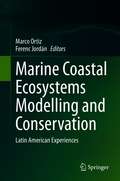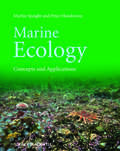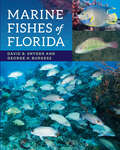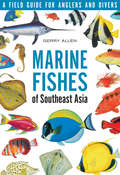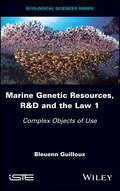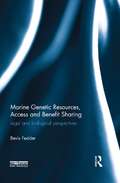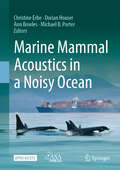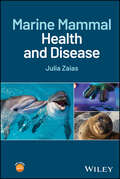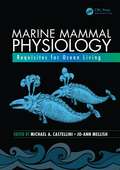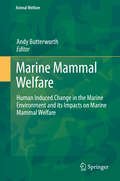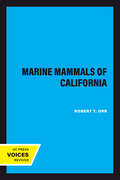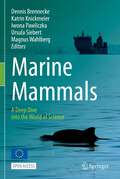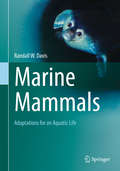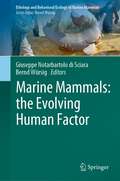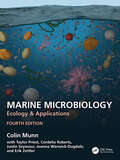- Table View
- List View
Marine Biology: Comparative Ecology of Planet Ocean
by Roberto Danovaro Paul SnelgroveMARINE BIOLOGY Marine Biology: Comparative Ecology of Planet Ocean provides a learning tool to those who love the ocean to help them understand and learn about the life that populates it, the extraordinary adaptations of marine organisms to their environment, and the spectacular variety of marine life forms that inhabit the many marine habitats and contribute to the life support system of Planet Ocean. The book introduces marine biology by seeing the ocean through the eyes of its inhabitants, describing the properties of sea water, the surface waters and its currents, and the characteristics of the seabed according to how marine organisms perceive, exploit, and shape them. This book explains to the reader and those who love the ocean not only how to recognize the most common marine organisms and habitats, from the coast to great depths, but it also explains their complex life cycles and the environmental factors controlling their distribution, reproduction, and growth. Finally, the book evaluates the role that living biota play in how different marine ecosystems function in order to understand better their characteristics, peculiarities, and threats. This book offers an up-to-date and comprehensive text on the study of marine biology, presenting insights into the methodologies scientists have adopted for the study of marine ecosystems. It also includes chapters about human impacts on marine biodiversity, from overfishing to climate change, from pollution (including microplastics), to alien-species invasions, from conservation of marine resources to the restoration of degraded marine habitats. The authors developed this text for Bachelor and Master’s level students taking classes on marine biology and marine ecology, but it will also interest high-school students and marine enthusiasts (dive masters, tour guides) who wish to deepen their knowledge of marine biology.
Marine Coastal Ecosystems Modelling and Conservation: Latin American Experiences
by Marco Ortiz Ferenc JordánThe book presents a collection of large-scale network-modeling studies on coastal systems in Latin America. It includes a novel description of the functioning of coastal complex ecosystems and also predicts how natural and human-made disturbances percolate through the networks. Coastal areas belong to the most populated ecosystems around the globe, and are massively influenced by human impacts such as shipping, mining, fisheries, tourism, pollution and human settlements. Even though many of these activities have facilitated socio-economic development, they have also caused a significant deterioration in natural populations, communities and ecosystems worldwide. Covering coastal marine ecosystems of Latin America such as the NE and SE Pacific, NW Atlantic and Caribbean areas, it discusses the construction of quantitative (Ecopath-Ecosim-Ecospace and Centrality of Node Sets) and semi-quantitative (Loop Analysis) multispecies trophic-network models to describe and assess the impacts of natural and human interventions like pelagic and benthic fishing as well as natural events such as El Niño, and La Niña. The book also features steady state (and/or near moving equilibrium) and dynamical models to support the management of exploited organisms, and applies and quantifies macroscopic indices, based on Ascendency (Ulanowicz) and Local Stability (Levins´ Loop Analysis). Further, it discusses the determination of the Keystone Species Complex Index, which is a holistic extension of the classical concept of Keystone Species (Paine), offering novel strategies for conservation monitoring and management.
Marine Distributions (The Royal Society of Canada Special Publications #5)
by Maxwell DunbarA symposium of the Royal Society of Canada was held in June 1962 to outline what is being done in Canadian oceanography to map salinity, temperature, and plankton in the waters around Canada and in the North Atlantic across to Europe. This volume, based on the symposium, emphasizes the interdisciplinary nature of research in marine biogeography and in the distribution of environmental factors in the sea. The book is intended to show the breadth of biogeographic work in the sea, and the relation between biogeography and the physics and chemistry of the marine environment. It serves also to introduce to the scientific public the new Serial Atlas of the Marine Environment, a scientific journal of a new kind of sponsored jointly by the Royal Society of Canada and the U.S. National Academy of Sciences.
Marine Ecology: Concepts and Applications
by Martin R. Speight Peter A. HendersonThis book began life as a series of lectures given to second and third year undergraduates at Oxford University. These lectures were designed to give students insights as to how marine ecosystems functioned, how they were being affected by natural and human interventions, and how we might be able to conserve them and manage them sustainably for the good of people, both recreationally and economically. This book presents 10 chapters, beginning with principles of oceanography important to ecology, through discussions of the magnitude of marine biodiversity and the factors influencing it, the functioning of marine ecosystems at within trophic levels such as primary production, competition and dispersal, to different trophic level interactions such as herbivory, predation and parasitism. The final three chapters look at the more applied aspects of marine ecology, discussion fisheries, human impacts, and management and conservation. Other textbooks covering similar topics tend to treat the topics from the point of view of separate ecosystems, with chapters on reefs, rocks and deep sea. This book however is topic driven as described above, and each chapter makes full use of examples from all appropriate marine ecosystems. The book is illustrated throughout with many full colour diagrams and high quality photographs. The book is aimed at undergraduate and graduate students at colleges and universities, and it is hoped that the many examples from all over the world will provide global relevance and interest. Both authors have long experience of research and teaching in marine ecology. Martin Speight’s first degree was in marine zoology at UCNW Bangor, and he has taught marine ecology and conservation at Oxford for 25 years. His research students study tropical marine ecology from the Caribbean through East Africa to the Far East. Peter Henderson is a Senior Research Associate at the University of Oxford, and is Director of Pisces Conservation in the UK. He has worked on marine and freshwater fisheries, as well as ecological and economic impacts and exploitation of the sea in North and South America as well as Europe.
Marine Fishes of Florida
by George H. Burgess David B. SnyderThe essential illustrated guide to Florida’s marine fishes.The most comprehensive book about Florida's marine fishes ever produced, Marine Fishes of Florida includes hundreds of photographs and descriptions of species you'll encounter—plus many that are rare—when diving, snorkeling, kayaking, or fishing. Coverage includes both the Atlantic and Gulf coastline, from habitats near the shore to deeper waters. Fishes found in coastal rivers and other brackish waters are fully represented, as are offshore species that venture into Florida's waters often enough to be called "occasional visitors." David B. Snyder and George H. Burgess intertwine personal observations with results from research studies to provide accurate—often surprising—details. The result is a set of beautifully succinct identification descriptions coupled with information about each species' natural history. From the largest sharks to the smallest cryptic gobies, from homely toadfishes to the spectacularly colored reef fishes, this book is certain to help you better understand the fish you've seen or hooked.Features of Marine Fishes of Florida include Color photographs by leading marine photographers Differentiation of adult and juvenile forms Coverage of 133 fish families and hundreds of species Size and geographical range data Natural history and conservation notes Explanations of geologic history and current habitats
Marine Fishes of Florida
by George H. Burgess David B. Snyder&“A highly useful and interesting reference for ichthyologists, recreational fish enthusiasts and those working in Florida waters . . . a worthy addition.&” —Marine Biology Research The most comprehensive book about Florida&’s marine fishes ever produced, Marine Fishes of Florida includes hundreds of photographs and descriptions of species you&’ll encounter—plus many that are rare—when diving, snorkeling, kayaking, or fishing. Coverage includes both the Atlantic and Gulf coastline, from habitats near the shore to deeper waters. Fishes found in coastal rivers and other brackish waters are fully represented, as are offshore species that venture into Florida&’s waters often enough to be called &“occasional visitors.&” David B. Snyder and George H. Burgess intertwine personal observations with results from research studies to provide accurate—often surprising—details. The result is a set of beautifully succinct identification descriptions coupled with information about each species&’ natural history. From the largest sharks to the smallest cryptic gobies, from homely toadfishes to the spectacularly colored reef fishes, this book is certain to help you better understand the fish you&’ve seen or hooked. Features of Marine Fishes of Florida include: Color photographs by leading marine photographersDifferentiation of adult and juvenile formsCoverage of 133 fish families and hundreds of speciesSize and geographical range dataNatural history and conservation notesExplanations of geologic history and current habitats&“Entertaining and informative . . . I think this book will be a great addition to the library of any biologist, fisher, diver or student, and I strongly recommend this book to anyone wishing to expand their knowledge of Florida fishes.&” —Environmental Biology of Fishes
Marine Fishes of Southeast Asia: A Field Guide for Anglers and Divers
by Gerry Allen Roger Swainston Jill RuseThis book contains nearly 2,000 hand-painted illustrations featuring 1,635 individual species. The paintings were completed over a 3-year period and are primarily based on photographs or color transparencies of either live fishes taken underwater or freshly caught specimens. In many cases preserved specimens at the Western Australian Museum have been consulted to ensure accuracy of detail and proportions. The end result is a colorful and highly comprehensive guide to the sea fishes of northern Australia and the adjacent Southeast Asian region.
Marine Genetic Resources 1
by Bleuenn GuillouxAdvances in research and development reveal the immense diversity and potential of marine genetic resources. Under international law, no specific regime applies to these complex and paradoxical objects of use. The Law of the Sea Convention sets a framework that is partly inadequate for this new category of resources. The Biodiversity Convention and the Nagoya Protocol only address the genetic resources of national areas. Patents allow their holder to exercise a monopoly on exploiting biotechnological creations to extensive claims, questioning the common nature of biodiversity and related knowledge. They hinder research and the objectives of biodiversity law. The legal and practical rules of physical and functional access vary in geometry. They focus on the valorization of research results, crystallizing conflicts of interest between suppliers and users. Sustainable research and development is essential to the knowledge and protection of marine biodiversity. The qualification of marine genetic resources in common, standard contractual tools, distributed research and development infrastructures, negotiation of an agreement on sustainable use and conservation of biodiversity beyond the limits of national jurisdiction, would To remove these inconsistencies.
Marine Genetic Resources, Access and Benefit Sharing: Legal and Biological Perspectives
by Bevis FedderAccess to genetic resources and Benefit Sharing (ABS) has been promoted under the Convention on Biological Diversity, with the aim of combining biodiversity conservation goals with economic development. However, as this book shows, since its inception in 1992, implementation has encountered multiple challenges and obstacles. This is particularly so in the marine environment, where interest in genetic resources for pharmaceuticals and nutrients has increased. This is partly because of the lack of clarity of terminology, but also because of the terms of the comprehensive law of the sea (UNCLOS) and transboundary issues of delineating ownership of marine resources. The author explains and compares relevant provisions and concepts under ABS and the law of the sea taking access, benefit sharing, monitoring, compliance, and dispute settlement into consideration. He also provides an overview of the implementation status of ABS-relevant measures in user states and identifies successful ABS transactions. A key unique feature of the book is to illustrate how biological databases can serve as the central scientific infrastructure to implement the global multilateral benefit sharing mechanism, proposed by the Nagoya Protocol. The research for this book was supported by both the Bremen International Graduate School for Marine Sciences (GLOMAR) and the International Research Training Group INTERCOAST – Integrated Coastal Zone and Shelf-Sea Research.
Marine Mammal Acoustics in a Noisy Ocean
by Michael B. Porter Christine Erbe Dorian Houser Ann BowlesThis open-access book invites its readers to dive into the depths of marine mammal bioacoustics. The ocean is a noisy place—naturally as well as anthropogenically. Our book explores the fundamentals of ocean acoustics, revealing the intricate sources of underwater noise that challenge marine life. Readers delve into the unique vocalizations of mysticetes, odontocetes, pinnipeds, otters, and sirenians, uncovering their diverse communication in stormy waters. The book presents research on marine mammal hearing and the impact of noise on their physiology and behavior, from the subtle behavioral responses to the broader biological significance of these effects. With insights into the management of anthropogenic noise, this book equips students, researchers, environmental managers, policy makers, conservationists, and enthusiasts alike with vital knowledge for protecting our ocean’s acoustic environments.
Marine Mammal Health and Disease
by Julia ZaiasA practical and authoritative reference for veterinary practitioners and technicians working with marine mammals in managed care or in free-ranging populations In Marine Mammal Health and Disease, distinguished veterinarian researcher Dr. Julia Zaias delivers an up-to-date and practical discussion of how to assess health and disease in marine mammals. The author offers a foundational, high-level understanding of normal/baseline conditions, how this baselines is altered by infectious agents, environment, or the host itself, and how to diagnose these changes and diseases. The book’s chapters are logically organized by health assessment and management, environmental influences on health, the basis of marine mammal health, disease, and animal welfare. It covers cetaceans, sirenia, pinnipeds, and other marine carnivores, as well as the pathology of cells and tissues, the mechanisms of disease, inflammation, and etiologic disease factors. Readers will also find: A thorough introduction to the basis of health and disease in marine animalsComprehensive explorations of health assessment and management, including clinical pathology and general preventative medicine and diagnosticsPractical discussions of both marine mammals in managed care environments and free-ranging animalsComplete treatments of environmental influences on health and disease in marine animals Perfect for students in veterinary and veterinary tech programs, conservation biology and medicine students, and marine mammal conservationists, managers, and trainers, Marine Mammal Health and Disease will also benefit researchers, wildlife and zoological veterinarians, veterinary technicians, and aquarium specialists and facility staff.
Marine Mammal Physiology: Requisites for Ocean Living (CRC Marine Biology Series)
by Michael A. Castellini Jo-Ann MellishSuppose you were designing a marine mammal. What would you need to think about to allow it to live in the ocean? How would you keep it warm? What would you design to allow it to dive for very long periods to extreme depths? Where would it find water to drink? How would you minimize the cost of swimming, and how would it find its prey in the deep an
Marine Mammal Welfare
by Andy ButterworthMarine mammals attract human interest – sometimes this interest is benign or positive – whale watching, conservation programmes for whales, seals, otters, and efforts to clear beaches of marine debris are seen as proactive steps to support these animals. However, there are many forces operating to affect adversely the lives of whales, seals, manatees, otters and polar bears – and this book explores how the welfare of marine mammals has been affected and how they have adapted, moved, responded and sometimes suffered as a result of the changing marine and human world around them. Marine mammal welfare addresses the welfare effects of marine debris, of human traffic in the oceans, of noise, of hunting, of whale watching and tourism, and of some of the less obvious impacts on marine mammals – on their social structures, on their behaviours and migration, and also of the effects on captivity for animals kept in zoos and aquaria. There is much to think and talk about – how marine mammals respond in a world dramatically influenced by man, how are their social structures affected and how is their welfare impacted?
Marine Mammals of California (California Natural History Guides #29)
by Robert T. OrrThis title is part of UC Press's Voices Revived program, which commemorates University of California Press’s mission to seek out and cultivate the brightest minds and give them voice, reach, and impact. Drawing on a backlist dating to 1893, Voices Revived makes high-quality, peer-reviewed scholarship accessible once again using print-on-demand technology. This title was originally published in 1972.This title is part of UC Press's Voices Revived program, which commemorates University of California Press’s mission to seek out and cultivate the brightest minds and give them voice, reach, and impact. Drawing on a backlist dating to 1893, Voices Revived</DIV
Marine Mammals: A Deep Dive into the World of Science
by Dennis Brennecke Katrin Knickmeier Iwona Pawliczka Ursula Siebert Magnus WahlbergThis highly-readable Open Access textbook provides basic background information about marine mammals and anthropogenic impacts on them. The book includes inspiring exercises for education school programs in natural sciences. The book also provides advice on career paths using case studies of marine scientists and veterinarians describing their journeys from student to profession. By sharing real-life career paths, readers find answers to questions such as “What needs to be considered when choosing a career in science?” and “What kind of tasks do scientists undertake on a daily basis?” Marine mammals are amongst some of the most celebrated creatures on Earth, with their high intelligence, social and communicating skills, and capacity for deep diving. Alongside general information about marine mammals, the book aims at generating awareness of the impact of litter and noise pollution on the marine environment using marine mammals as an example. Huge numbers of marine animals, including marine mammals, die every year from entanglement in fishing gear, by ingestion of litter or because of chemical pollution. In the last decade many technological and scientific tools have been developed to aid research, for instance miniaturised sound recorders which can be attached to cetaceans and seals and record noise levels around them, their vocal production as well as their diving behaviour. This Open Access textbook can be used by undergraduate students interested in the fundamentals of marine mammal biology and medicine, and in pursuing the profession of a marine scientist.
Marine Mammals: Adaptations for an Aquatic Life
by Randall W. DavisThis comprehensive book provides new insights into the morphological, metabolic, thermoregulatory, locomotory, diving, sensory, feeding, and sleep adaptations of Cetacea (whales and dolphins), Pinnipedia (seals, sea lions and walrus), Sirenia (manatees and dugongs) and sea otters for an aquatic life. Each chapter reviews the discoveries from previous studies and integrates recent research using new techniques and technology. Readers will gain an understanding of the remarkable adaptations that enable marine mammals to spend all or most of their lives at sea, often while hunting prey at depth.
Marine Mammals: The Evolving Human Factor (Ethology and Behavioral Ecology of Marine Mammals)
by Bernd Würsig Giuseppe Notarbartolo di SciaraThe seventh volume in the series “Ethology and Behavioral Ecology of Marine Mammals” describes aspects of the often-complex relationship between humans and marine mammals. From a primeval condition of occasional predators, during the last century humans have become a major factor negatively affecting the status of most marine mammals through over-hunting, habitat encroachment and environmental degradation. This has led to the extirpation of many marine mammal populations and even to the extinction of species. However, in parallel to this destructive drive, since antiquity humanity has been influenced by a strong fascination for marine mammals, which contributes today to an increased human appreciation of the natural world admixed with widespread concern for its degrading condition. The special status occupied by marine mammals in human imagination and affection stands in stark contrast with the current predicament of many populations still threatened by the doings of Homo sapiens: a condition emblematic of the relationship of humanity with nature, and key to understanding where humanity is heading.
Marine Microbiology: Ecology & Applications
by Colin Munn Taylor Priest Cordelia Roberts Justin Seymour Joanna Warwick-Dugdale Erik ZettlerThe fourth edition of this bestselling text has been rigorously updated to reflect major new discoveries and concepts since 2019. This new edition reflects important new findings in marine microbiology revealed by development of high-throughput sequencing, meta-omics, and single-cell technologies, and the ability to analyse and interpret large datasets. Furthermore, it presents major new insights into topics such as the physiology of planktonic microbes and their role in ocean processes; the impacts of rising CO2 levels and climate change on the microbial community structure and ocean processes; the evolution of viruses, organelles, and eukaryotic life; interactions of microbes with plastic pollution; and emerging diseases of marine life and their control. All chapters have been significantly expanded, with full colour diagrams, illustrations, and boxes to aid students’ interest and understanding. Novel pedagogy is designed to encourage students to explore current high-profile research topics.This is the only textbook addressing such a broad range of topics in the specific area of marine microbiology, now a core topic within broader marine science degrees.
Marine Organisms as Model Systems in Biology and Medicine (Results and Problems in Cell Differentiation #65)
by Jacek Z. Kubiak Malgorzata KlocThis book highlights the potential advantages of using marine invertebrates like tunicates, echinoderms, sponges and cephalopods as models in both biological and medical research. Bioactive compounds found in marine organisms possess antibacterial, antifungal, anti-diabetic and anti-inflammatory properties, and can affect the immune and nervous systems. Despite substantial research on the medicinal attributes of various marine invertebrates, they are still very much underrepresented in scientific literature: the majority of cell, developmental and evolutionary scientific journals only publish research conducted on a few well-known model systems like Drosophila melanogaster or Xenopus laevis. Addressing that gap, this book introduces readers to new model organisms like starfish or nemertera. By showing their benefits with regard to regeneration, stem cell research and Evo-Devo, the authors provide a cross-sectional view encompassing various disciplines of biological research. As such, this book will not only appeal to scientists currently working on marine organisms, but will also inspire future generations to pursue research of their own.
Marine Otter Conservation
by Liliana Ayala Raúl Sánchez-Scaglioni Gonzalo Medina-VogelThis book offers a multidisciplinary approach to conservation issues related to the marine otter (Lontra felina). The main goal is the systematization of different research efforts on this species, to contribute with conservation policy design and implementation. The authors contribute their achievements in conservation, ecology, status in freshwater habitats, habitat fragmentation effects, interaction with human activities and recommendations for an effective conservation of the species. The book is directed first and foremost towards researchers and authorities and people involved in conservation tasks of otters.Despite in the last decades some studies and efforts on Lontra felina has carried in Peru and Chile, some information can be gathered to fill the gaps on marine otter conservation in Peru. That is the main goal of the book Conservation of Marine Otter. Moreover, the publication will be the first book published at international level on Lontra felina with the participation of several experimented researchers on this threatened and endemic species.
Marine Science
by Thomas F. GreeneWritten for high school students, this book provides complete coverage of a one-year high school course in marine biology/oceanography.
Marine and Freshwater Toxins
by P. Gopalakrishnakone Vidal Haddad Jr. Aurelia Tubaro Euikyung Kim William R. KemThis book presents the structure of the main toxins of aquatic origin, their distribution, producing species and vectors, their mechanisms of action, the clinical aspects of envenomation in humans, their effects in laboratory or wild animals, their toxicokinetic properties, including the relevant treatment, detection methods and regulatory aspects for management. The work also presents the main species associated with the injuries, poisonings their toxins, mechanism of action and the clinical aspects of the envenomations by aquatic animals and discusses the actual measures utilized in the first aid and hospital treatments. Marine toxins such as palytoxins, brevetoxins, saxitoxin, ciguatoxins, okadaic acid, azaspiracid toxins, equinatoxins are also dealt with in this volume. These toxins can be lethal as well as having a complex and large molecular structure and display mechanisms by which they act very specifically on targets, receptors or on critical body proteins. The marine and freshwater environments are the new frontiers of humanity, but the increase of economic and tourist activities provoke nasty encounters between aquatic animals and humans. The main victims are swimmers, professional and sportive fishermen, surfers and scuba divers as well as people working in related fields. The identification, knowledge and treatment of envenomations caused by venomous and poisonous animals are not adequate and the prevention of injuries still is not possible. Additionally, the immense potential of the pharmacologic effects of their toxins is not fully explored. Toxins of venomous aquatic animals can cause proteolysis, myotoxicity, hemotoxicity (mainly hemolysis), cytotoxicity and neurotoxicity. The neurotoxicity is generally associated with toxins of dinoflagellates and cyanobacteria, present in poisonous and/or contaminated invertebrates and fish.
Mario Makes a Move
by Jill McElmurryAccording to Publishers Weekly in a starred review, this picture book "capture[s] the exuberance of the creative spirit alongside the quirks of a character accepting his limitations." Mario is a squirrel who loves to invent amazing moves, like the Super Looper and Tail, Don't Fail. But though his parents ooh and ahh at whatever he does, his friend Isabelle is not so easily impressed. When she points out that anyone can have a move, Mario must find some other way to stand out.Sometimes being amazing is hard work, as shown in this zany yet accessible picture book from Jill McElmurry, illustrator of The One and Only Marigold and Little Blue Truck. Young readers will instantly recognize themselves in Mario, as he searches for his one-of-a-kind talent. Here is a hilarious read-aloud that will have little ones oohing and ahhing—and trying out some moves of their own.
Marion Strikes a Pose: Amy Meets Her Stepsister; Ellie's Lovely Idea; Liz At Marigold Lake; Marion Strikes A Pose (The Critter Club #8)
by Callie BarkleyFashionista Marion enters a styling competition in the eighth book of the Critter Club series—but will she regret helping out one of her competitors?Marion is so excited. There’s an upcoming kids’ fashion show for charity, and the students at Santa Vista Elementary get to style an outfit for it! Since only one design from each grade will get picked for the show, Marion knows she has to win. So she’s surprised when a girl named Olivia asks her for some style advice. Marion agrees to help Olivia, and actually has fun doing it! But problems arise when Marion realizes that Olivia has designed the exact outfit Marion had planned to present to the judges. So Marion tells a little white lie in order to get her way. At first, she is excited to impress the judges, but soon, another feeling creeps up on her. Is it guilt? Will Marion tell Olivia what she did? And whose outfit will get picked for the fashion show? Plus, Marion deals with taking care of some frogs at The Critter Club! With easy-to-read language and illustrations on almost every page, The Critter Club chapter books are perfect for beginning readers.
Marion Takes Charge (The Critter Club #12)
by Marsha Riti Callie BarkleyMarion finally gets to babysit her little sister Gabby in the twelfth book of The Critter Club series!Marion has always wanted to babysit her sister--but her parents have said she is too young! When they finally ask Marion to watch Gabby during a party at their house, Marion can't wait! But she quickly finds out that babysitting isn't as easy as it looks. Gabby won't listen to Marion at all. After getting upset about losing a board game, she makes a total mess and even draws on the table! When Marion gets called to the Critter Club to help out with a run-away cat, Gabby tags along and causes even more trouble! Maybe being a sister is better than being a sitter... With easy-to-read language and illustrations on almost every page, The Critter Club chapter books are perfect for beginning readers!

